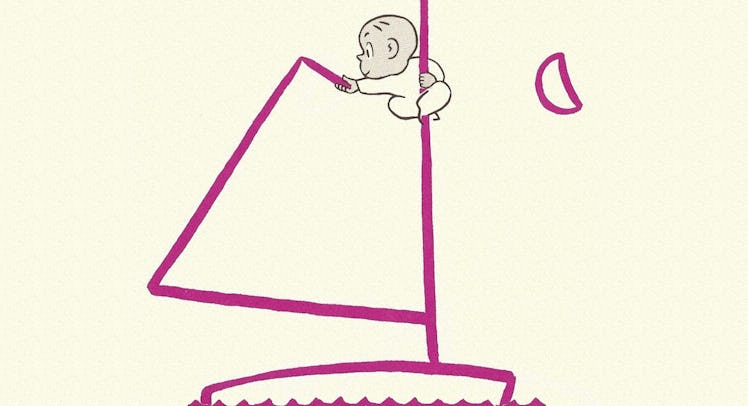Harold and His Purple Crayon Never Make It Home. That’s Fine.
If "Harold" is my son's first blush with dystopian literature, that's fine. If it teaches him to challenge the status quo and draw himself a better world from scratch — that’s even better.

Harold never makes it home. This haunting realization first hit me one evening, after my son and I had endured a fourth consecutive rendition of Harold and the Purple Crayon. I mulled it over, shifting as my son wiggled off my lap. Crockett Johnson’s childhood classic was published in 1955. My parents read it to me; their parents read it to them. How did we never notice?
Harold is still trapped in Purple Crayon Hell.
Allow me to explain. At its surface, “Harold” is a surrealistic story of exploration and creativity. Armed with nothing but a purple crayon and his vivid imagination, Harold draws a moon to light his way, an apple tree (with a dragon to guard it), and a picnic lunch consisting of “all nine kinds of pie that Harold liked best.” But when it comes time to return home, Harold is flummoxed. He draws a city like his own, but can’t find his house. Frantic, he draws a police officer who gives predictably bad directions. In the end — spoiler alert? — Harold remembers that he can always see the moon from his bedroom window, so he draws a window around the moon, sketches himself a purple bed, and falls asleep. He’s home.
Except he’s not home. Harold and the Purple Crayon is Inception for kids. The 2010 thriller suggests that you can fall into your own dreams so deeply that you never escape, and the best you can hope for is that your imagination will recreate a world so similar to your own that you cannot recognize it for what it is — a dream, a nightmare. This, too, is Harold’s fate. He ends the book lost in a land entirely defined by his own imagination. It has a window, a moon, a bed, but it isn’t home. Nonetheless, Harold drifts off to sleep content. It’s close enough for him.
I’m not the first person to seriously overthink Harold’s odd adventure. In my search for other adults who ruin children’s books, I discovered a peer in Rebecca Vitkus of the publishing company Simon & Schuster. She takes it one step further: “Harold and the Purple Crayon serves as a metafictional text in which a self-aware young boy realizes the power of his autonomy while simultaneously learning the limits of his abilities, disassociating the idea of returning home with traditional sentimentality.” In other words, Vitkus agrees that Harold never makes it home. But that’s okay, because he learns to separate “sentimentality” from “home”.
Perhaps, then, “Harold” is less a dystopian fantasy and more a coming-of-age tract. Harold is dissatisfied with his current situation, whatever it may be. He knows he has the creativity and drive to do better, so he does just that — he draws himself a new life. It’s not the same as his old life, sure. It lacks stability; it needs to be sketched into being, for one. As anyone who has struck out on their own knows, that first night can be lonely and scary. You may have to draw up the bedsheets by yourself. There’s a strong temptation to return to the familiar and inferior, to abandon the dream out of fear of failure and the unknown. But Harold? Harold boldly marches onward.
Look, sometimes a crayon is just a crayon. It’s possible that Crockett Johnson would be horrified by my exegesis. But I’m satisfied with the classic children’s book, either way. If it merely informs my son is that his imagination can create apple trees, dragons, and pie, there’s nothing wrong with that. And if “Harold” is my son’s first blush with dystopian literature, that’s fine too. But if it teaches him to challenge the status quo and, despite his fears, draw himself a better world from scratch — then it was worth every penny.